2025
|
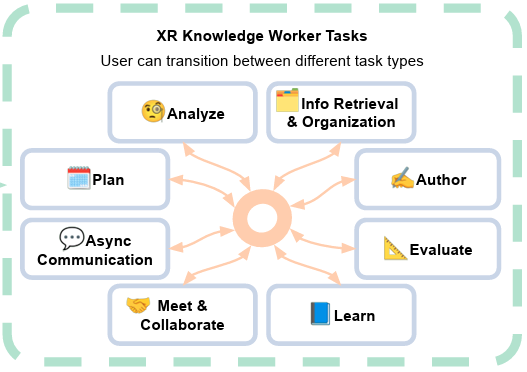 | Matt Gottsacker; Yahya Hmaiti; Mykola Maslych; Hiroshi Furuya; Gerd Bruder; Gregory F Welch; Joseph J. LaViola Jr. XR-First Design for Productivity: A Conceptual Framework for Enabling Efficient Task Switching in XR Proceedings Article In: IEEE International Symposium on Mixed and Augmented Reality (ISMAR) Adjunct Proceedings, 2025. @inproceedings{nokey,
title = {XR-First Design for Productivity: A Conceptual Framework for Enabling Efficient Task Switching in XR},
author = {Matt Gottsacker and Yahya Hmaiti and Mykola Maslych and Hiroshi Furuya and Gerd Bruder and Gregory F Welch and Joseph J. LaViola Jr.},
url = {https://sreal.ucf.edu/wp-content/uploads/2025/09/ISMAR25__Workshop_Paper__xrWORKS__VR_World_Switch_UI-11.pdf},
year = {2025},
date = {2025-10-08},
urldate = {2025-10-08},
booktitle = {IEEE International Symposium on Mixed and Augmented Reality (ISMAR) Adjunct Proceedings},
abstract = {A core component of completing tasks efficiently in computer supported knowledge work is the ability for users to rapidly switch their focus (and interaction) across different applications using various shortcuts and gestures. This feature set has been explored in research, and several modern consumer extended reality (XR) headsets now support loading multiple applications windows at once. However, many XR applications that are useful for knowledge work involve rich spatial information, which window-based metaphors do not sufficiently represent nor afford appropriate interaction. In modern XR headsets, such immersive applications run as siloed experiences, requiring the user to fully exit one before starting another. We present a vision for achieving an XR-first, user-centric paradigm for efficient context switching in XR to encourage and guide future research and development of XR context- and task-switching interfaces.},
keywords = {},
pubstate = {published},
tppubtype = {inproceedings}
}
A core component of completing tasks efficiently in computer supported knowledge work is the ability for users to rapidly switch their focus (and interaction) across different applications using various shortcuts and gestures. This feature set has been explored in research, and several modern consumer extended reality (XR) headsets now support loading multiple applications windows at once. However, many XR applications that are useful for knowledge work involve rich spatial information, which window-based metaphors do not sufficiently represent nor afford appropriate interaction. In modern XR headsets, such immersive applications run as siloed experiences, requiring the user to fully exit one before starting another. We present a vision for achieving an XR-first, user-centric paradigm for efficient context switching in XR to encourage and guide future research and development of XR context- and task-switching interfaces. |
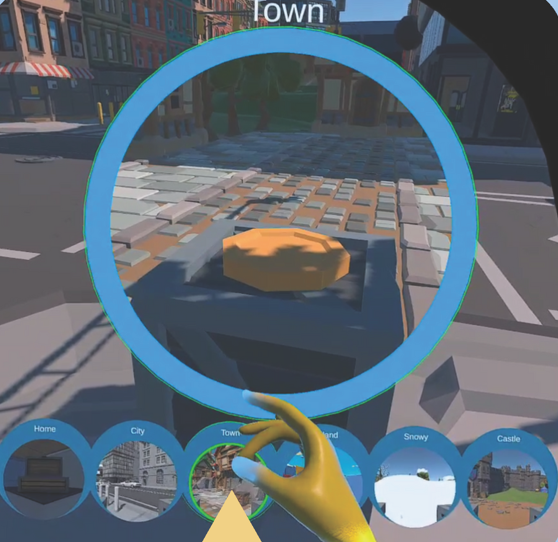 | Matt Gottsacker; Yahya Hmaiti; Mykola Maslych; Hiroshi Furuya; Gerd Bruder; Gregory F Welch; Joseph J. LaViola Jr. From Alt-Tab to World-Snap: Exploring Different Metaphors for Swift and Seamless VR World Switching Proceedings Article In: IEEE International Symposium on Mixed and Augmented Reality, pp. 1-2, 2025. @inproceedings{nokey,
title = {From Alt-Tab to World-Snap: Exploring Different Metaphors for Swift and Seamless VR World Switching},
author = {Matt Gottsacker and Yahya Hmaiti and Mykola Maslych and Hiroshi Furuya and Gerd Bruder and Gregory F Welch and Joseph J. LaViola Jr.},
url = {https://sreal.ucf.edu/wp-content/uploads/2025/09/ISMAR25__Demo__VR_World_Switch_UI.pdf},
year = {2025},
date = {2025-10-08},
urldate = {2025-10-08},
booktitle = {IEEE International Symposium on Mixed and Augmented Reality},
pages = {1-2},
abstract = {Today's personal computers and handheld devices afford users the ability to rapidly switch between different applications, e.g., using keyboard shortcuts and swipe gestures. In today's virtual reality (VR) systems, immersive applications are siloed experiences that users must fully exit before starting another. We demonstrate eight prototypes of world switching interfaces that let users preview, select, and transition across multiple virtual environments in a continuous interaction, mirroring the ``Alt+Tab" agility of desktop multitasking. We developed these techniques based on portals and worlds-in-miniature (WiM) metaphors that reveal the destination environment before triggering a full transition. },
keywords = {},
pubstate = {published},
tppubtype = {inproceedings}
}
Today's personal computers and handheld devices afford users the ability to rapidly switch between different applications, e.g., using keyboard shortcuts and swipe gestures. In today's virtual reality (VR) systems, immersive applications are siloed experiences that users must fully exit before starting another. We demonstrate eight prototypes of world switching interfaces that let users preview, select, and transition across multiple virtual environments in a continuous interaction, mirroring the ``Alt+Tab" agility of desktop multitasking. We developed these techniques based on portals and worlds-in-miniature (WiM) metaphors that reveal the destination environment before triggering a full transition. |
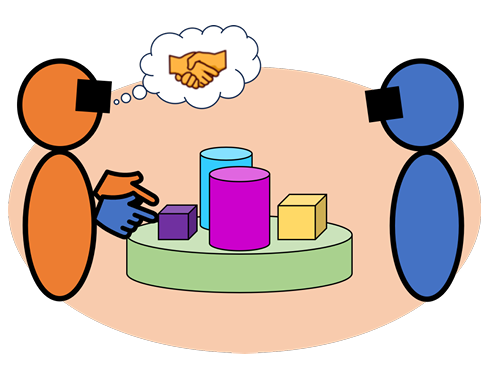 | Matt Gottsacker; Nels Numan; Anthony Steed; Gerd Bruder; Gregory F. Welch; Steve Feiner Decoupled Hands: An Approach for Aligning Perspectives in Collaborative Mixed Reality Proceedings Article In: ACM CHI Conference on Human Factors in Computing Systems (CHI '25), 2025. @inproceedings{gottsacker2025perspectives,
title = {Decoupled Hands: An Approach for Aligning Perspectives in Collaborative Mixed Reality},
author = {Matt Gottsacker and Nels Numan and Anthony Steed and Gerd Bruder and Gregory F. Welch and Steve Feiner},
url = {https://sreal.ucf.edu/wp-content/uploads/2025/03/CHI25__LBW__MR_Perspective_Alignment_preprint.pdf},
doi = {10.1145/3706599.3720219},
year = {2025},
date = {2025-04-26},
urldate = {2025-04-26},
booktitle = {ACM CHI Conference on Human Factors in Computing Systems (CHI '25)},
abstract = {When collaborating relative to a shared 3D virtual object in mixed reality (MR), users may experience communication issues arising from differences in perspective. These issues include occlusion (e.g., one user not being able to see what the other is referring to) and inefficient spatial references (e.g., "to the left of this" may be confusing when users are positioned opposite to each other). This paper presents a novel technique for automatic perspective alignment in collaborative MR involving co-located interaction centered around a shared virtual object. To align one user’s perspective on the object with a collaborator’s, a local copy of the object and any other virtual elements that reference it (e.g., the collaborator’s hands) are dynamically transformed. The technique does not require virtual travel and preserves face-to-face interaction. We created a prototype application to demonstrate our technique and present an evaluation methodology for related MR collaboration and perspective alignment scenarios.},
keywords = {},
pubstate = {published},
tppubtype = {inproceedings}
}
When collaborating relative to a shared 3D virtual object in mixed reality (MR), users may experience communication issues arising from differences in perspective. These issues include occlusion (e.g., one user not being able to see what the other is referring to) and inefficient spatial references (e.g., "to the left of this" may be confusing when users are positioned opposite to each other). This paper presents a novel technique for automatic perspective alignment in collaborative MR involving co-located interaction centered around a shared virtual object. To align one user’s perspective on the object with a collaborator’s, a local copy of the object and any other virtual elements that reference it (e.g., the collaborator’s hands) are dynamically transformed. The technique does not require virtual travel and preserves face-to-face interaction. We created a prototype application to demonstrate our technique and present an evaluation methodology for related MR collaboration and perspective alignment scenarios. |
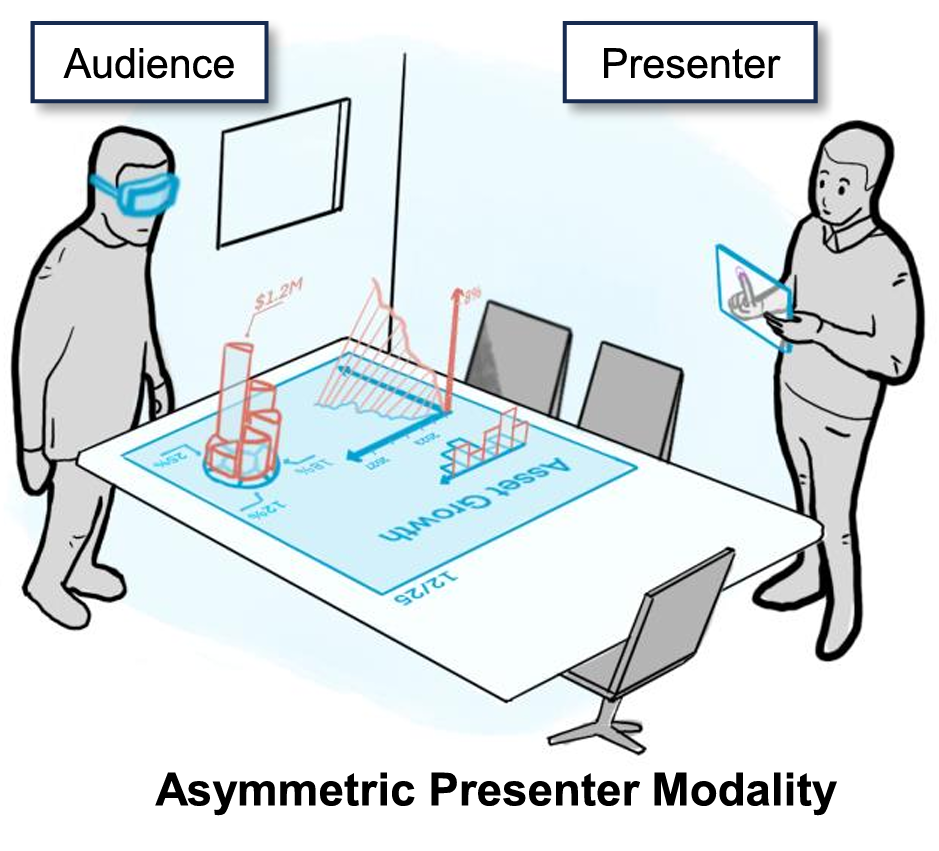 | Matt Gottsacker; Mengyu Chen; David Saffo; Feiyu Lu; Benjamin Lee; Blair MacIntyre Examining the Effects of Immersive and Non-Immersive Presenter Modalities on Engagement and Social Interaction in Co-located Augmented Presentations Proceedings Article In: ACM CHI Conference on Human Factors in Computing Systems (CHI '25), 2025. @inproceedings{gottsacker2025presentations,
title = {Examining the Effects of Immersive and Non-Immersive Presenter Modalities on Engagement and Social Interaction in Co-located Augmented Presentations},
author = {Matt Gottsacker and Mengyu Chen and David Saffo and Feiyu Lu and Benjamin Lee and Blair MacIntyre},
url = {https://sreal.ucf.edu/wp-content/uploads/2025/03/CHI25__Paper__Immersive_Presentation_Study_preprint.pdf},
doi = {10.1145/3706598.3713346},
year = {2025},
date = {2025-04-26},
urldate = {2025-04-26},
booktitle = {ACM CHI Conference on Human Factors in Computing Systems (CHI '25)},
abstract = {Head-worn augmented reality (AR) allows audiences to be immersed and engaged in stories told by live presenters. While presenters may also be in AR to have the same level of immersion and awareness as their audience, this symmetric presentation style may diminish important social cues such as eye contact. In this work, we examine the effects this (a)symmetry has on engagement, group awareness, and social interaction in co-located one-on-one augmented presentations. We developed a presentation system incorporating 2D/3D content that audiences can view and interact with in AR, with presenters controlling and delivering the presentation in either a symmetric style in AR, or an asymmetric style with a handheld tablet. We conducted a within- and between-subjects evaluation with 12 participant pairs to examine the differences between these symmetric and asymmetric presentation modalities. From our findings, we extracted four themes and derived strategies and guidelines for designers interested in augmented presentations.},
keywords = {},
pubstate = {published},
tppubtype = {inproceedings}
}
Head-worn augmented reality (AR) allows audiences to be immersed and engaged in stories told by live presenters. While presenters may also be in AR to have the same level of immersion and awareness as their audience, this symmetric presentation style may diminish important social cues such as eye contact. In this work, we examine the effects this (a)symmetry has on engagement, group awareness, and social interaction in co-located one-on-one augmented presentations. We developed a presentation system incorporating 2D/3D content that audiences can view and interact with in AR, with presenters controlling and delivering the presentation in either a symmetric style in AR, or an asymmetric style with a handheld tablet. We conducted a within- and between-subjects evaluation with 12 participant pairs to examine the differences between these symmetric and asymmetric presentation modalities. From our findings, we extracted four themes and derived strategies and guidelines for designers interested in augmented presentations. |
![[Poster] Inducing Unintentional Positional Drift (UPD) in Virtual Reality via Physical Rotations and the Illusion of Leaning](https://sreal.ucf.edu/wp-content/uploads/2025/03/Roll-Example-e1741105590923-150x150.jpg) | Zubin Datta Choudhary; Ferran Argelaguet; Gerd Bruder; Greg Welch [Poster] Inducing Unintentional Positional Drift (UPD) in Virtual Reality via Physical Rotations and the Illusion of Leaning Proceedings Article In: Proceedings of IEEE Conference on Virtual Reality and 3D User Interfaces (IEEE VR) 2025., 2025. @inproceedings{Choudhary2025,
title = {[Poster] Inducing Unintentional Positional Drift (UPD) in Virtual Reality via Physical Rotations and the Illusion of Leaning},
author = {Zubin Datta Choudhary and Ferran Argelaguet and Gerd Bruder and Greg Welch},
url = {https://sreal.ucf.edu/wp-content/uploads/2025/03/Camera-Ready_UPD_Roll_Poster_IEEE_VR_25.pdf},
year = {2025},
date = {2025-03-10},
urldate = {2025-03-10},
booktitle = {Proceedings of IEEE Conference on Virtual Reality and 3D User Interfaces (IEEE VR) 2025.},
abstract = {In Virtual Reality (VR) users often turn their bodies during experiences. Virtual navigation techniques use body rotations and virtual forward translations to simulate movement. Despite being designed for stationary use, these techniques can cause Unintentional Positional Drift (UPD), impacting user safety and VR experiences. We carried out a human-participant study, approved by our university ethics board, involving 20 participants performing repetitive rotation tasks. Our study focused on intentionally inducing UPD via physical rotations by adding an offset to the VR camera’s roll angle, creating a visual illusion of “leaning” or “banking.” Our results show that camera roll offsets induced UPD along participants initial left-right axis under specific conditions. Additionally, rotation magnitude and forward translation flow affected UPD, while no significant effects were found due to rotation direction.},
keywords = {},
pubstate = {published},
tppubtype = {inproceedings}
}
In Virtual Reality (VR) users often turn their bodies during experiences. Virtual navigation techniques use body rotations and virtual forward translations to simulate movement. Despite being designed for stationary use, these techniques can cause Unintentional Positional Drift (UPD), impacting user safety and VR experiences. We carried out a human-participant study, approved by our university ethics board, involving 20 participants performing repetitive rotation tasks. Our study focused on intentionally inducing UPD via physical rotations by adding an offset to the VR camera’s roll angle, creating a visual illusion of “leaning” or “banking.” Our results show that camera roll offsets induced UPD along participants initial left-right axis under specific conditions. Additionally, rotation magnitude and forward translation flow affected UPD, while no significant effects were found due to rotation direction. |
 | Hiroshi Furuya; Jasmine Joyce DeGuzman; Zubin Datta Choudhary; Matthew Gottsacker; Gerd Bruder; Gregory F. Welch How Does Presence Affect Trust in Simulated Autonomous Agents? Proceedings Article In: Proceedings of the 2025 IEEE Conference on Virtual Reality and 3D User Interfaces Abstracts and Workshops (IEEE VRW): 1st Annual Workshop on Real and Virtual Spaces Influences (ReVISI), pp. 1-2, 2025. @inproceedings{Furuya2025hc,
title = {How Does Presence Affect Trust in Simulated Autonomous Agents?},
author = {Hiroshi Furuya and Jasmine Joyce DeGuzman and Zubin Datta Choudhary and Matthew Gottsacker and Gerd Bruder and Gregory F. Welch},
url = {https://sreal.ucf.edu/wp-content/uploads/2025/10/How_Does_Presence_Affect_Trust_in_Simulated_Autonomous_Agents.pdf},
doi = {10.1109/VRW66409.2025.00109},
year = {2025},
date = {2025-03-08},
urldate = {2025-03-08},
booktitle = {Proceedings of the 2025 IEEE Conference on Virtual Reality and 3D User Interfaces Abstracts and Workshops (IEEE VRW): 1st Annual Workshop on Real and Virtual Spaces Influences (ReVISI)},
pages = {1-2},
abstract = {Autonomous agents present important novel capabilities for a wide swath of applications like simulating interactions between humans and agents. Simulating these interactions in VR has become an important tool for evaluating the effects of agents on human behavior and performance, including human-agent trust. This position paper presents research opportunities in the use of real-world multi-modal feedback and real-world priming experiences may have on the validity of trust measurements taken from simulated human-agent interactions in VR. In addition, it presents a hypothetical experiment addressing research questions related to this topic.},
keywords = {},
pubstate = {published},
tppubtype = {inproceedings}
}
Autonomous agents present important novel capabilities for a wide swath of applications like simulating interactions between humans and agents. Simulating these interactions in VR has become an important tool for evaluating the effects of agents on human behavior and performance, including human-agent trust. This position paper presents research opportunities in the use of real-world multi-modal feedback and real-world priming experiences may have on the validity of trust measurements taken from simulated human-agent interactions in VR. In addition, it presents a hypothetical experiment addressing research questions related to this topic. |
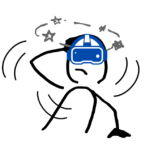 | Jasmine Joyce DeGuzman; Kaori Hirano; Tabitha Peck; Alice Guth; Evan Suma Rosenberg; Tongyu Nie Reduction of Motion Complexity as an Objective Indicator of Cybersickness in Virtual Reality Proceedings Article In: Proceedings of IEEE Conference on Virtual Reality and 3D User Interfaces (IEEE VR) 2025., pp. 1-9, 2025. @inproceedings{DeGuzman2025Reduction,
title = {Reduction of Motion Complexity as an Objective Indicator of Cybersickness in Virtual Reality},
author = {Jasmine Joyce DeGuzman and Kaori Hirano and Tabitha Peck and Alice Guth and Evan Suma Rosenberg and Tongyu Nie},
url = {https://sreal.ucf.edu/wp-content/uploads/2024/01/2025_IEEE_VR_Motion_Complexity-1.pdf},
year = {2025},
date = {2025-02-25},
urldate = {2025-02-25},
booktitle = {Proceedings of IEEE Conference on Virtual Reality and 3D User Interfaces (IEEE VR) 2025.},
pages = {1-9},
abstract = {Subjective measures, such as the Simulator Sickness Questionnaire (SSQ), Fast Motion Sickness Questionnaire (FMS), and discomfort scores, are widely used to assess cybersickness, but they often interrupt the user experience and are prone to bias. To overcome these limitations, researchers have also investigated objective indicators, though some approaches, such as using physiological data, can be cumbersome and impractical. Based on the loss of complexity hypothesis, which suggests that certain conditions, such as disease or aging, can produce a reduction of complexity in physiological system dynamics, we conducted an initial investigation of the relationship between movement complexity and cybersickness. We analyzed motion tracking collected from two previous cybersickness studies using the d95 score, a complexity metric derived using principal component analysis. The results revealed a systematic relationship between movement complexity and cybersickness across both experiments. Higher discomfort scores were associated with a reduction in complexity, thereby supporting the loss of complexity hypothesis. Furthermore, the 9-DOF complexity measure, which includes both physical head movement and virtual camera motion, was a more sensitive indicator than the 6-DOF measure computed from physical movements alone. These initial findings suggest that movement complexity may be a useful objective indicator for future cybersickness research.},
keywords = {},
pubstate = {published},
tppubtype = {inproceedings}
}
Subjective measures, such as the Simulator Sickness Questionnaire (SSQ), Fast Motion Sickness Questionnaire (FMS), and discomfort scores, are widely used to assess cybersickness, but they often interrupt the user experience and are prone to bias. To overcome these limitations, researchers have also investigated objective indicators, though some approaches, such as using physiological data, can be cumbersome and impractical. Based on the loss of complexity hypothesis, which suggests that certain conditions, such as disease or aging, can produce a reduction of complexity in physiological system dynamics, we conducted an initial investigation of the relationship between movement complexity and cybersickness. We analyzed motion tracking collected from two previous cybersickness studies using the d95 score, a complexity metric derived using principal component analysis. The results revealed a systematic relationship between movement complexity and cybersickness across both experiments. Higher discomfort scores were associated with a reduction in complexity, thereby supporting the loss of complexity hypothesis. Furthermore, the 9-DOF complexity measure, which includes both physical head movement and virtual camera motion, was a more sensitive indicator than the 6-DOF measure computed from physical movements alone. These initial findings suggest that movement complexity may be a useful objective indicator for future cybersickness research. |
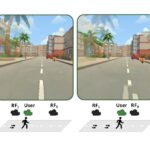 | Tongyu Nie; Courtney Hutton Pospick; Ville Cantory; Danhua Zhang; Jasmine Joyce DeGuzman; Victoria Interrante; Isayas Berhe Adhanom; Evan Suma Rosenberg Peripheral Teleportation: A Rest Frame Design to Mitigate Cybersickness During Virtual Locomotion Journal Article In: IEEE Transaction on Visualization and Computer Graphics, pp. 1-10, 2025, (Best Paper Award, IEEE VR 2025). @article{nie2025pt,
title = {Peripheral Teleportation: A Rest Frame Design to Mitigate Cybersickness During Virtual Locomotion},
author = {Tongyu Nie and Courtney Hutton Pospick and Ville Cantory and Danhua Zhang and Jasmine Joyce DeGuzman and Victoria Interrante and Isayas Berhe Adhanom and Evan Suma Rosenberg},
url = {https://sreal.ucf.edu/wp-content/uploads/2025/02/2025_IEEE_VR__TVCG__Peripheral_Teleportation.pdf},
year = {2025},
date = {2025-02-25},
urldate = {2025-02-25},
journal = {IEEE Transaction on Visualization and Computer Graphics},
pages = {1-10},
abstract = {Mitigating cybersickness can improve the usability of virtual reality (VR) and increase its adoption. The most widely used technique, dynamic field-of-view (FOV) restriction, mitigates cybersickness by blacking out the peripheral region of the user’s FOV. However, this approach reduces the visibility of the virtual environment. We propose peripheral teleportation, a novel technique that creates a rest frame (RF) in the user's peripheral vision using content rendered from the current virtual environment. Specifically, the peripheral region is rendered by a pair of RF cameras whose transforms are updated by the user's physical motion. We apply alternating teleportations during translations, or snap turns during rotations, to the RF cameras to keep them close to the current viewpoint transformation. Consequently, the optical flow generated by RF cameras matches the user's physical motion, creating a stable peripheral view. In a between-subjects study (N=90), we compared peripheral teleportation with a traditional black FOV restrictor and an unrestricted control condition. The results showed that peripheral teleportation significantly reduced discomfort and enabled participants to stay immersed in the virtual environment for a longer duration of time. Overall, these findings suggest that peripheral teleportation is a promising technique that VR practitioners may consider adding to their cybersickness mitigation toolset.},
note = {Best Paper Award, IEEE VR 2025},
keywords = {},
pubstate = {published},
tppubtype = {article}
}
Mitigating cybersickness can improve the usability of virtual reality (VR) and increase its adoption. The most widely used technique, dynamic field-of-view (FOV) restriction, mitigates cybersickness by blacking out the peripheral region of the user’s FOV. However, this approach reduces the visibility of the virtual environment. We propose peripheral teleportation, a novel technique that creates a rest frame (RF) in the user's peripheral vision using content rendered from the current virtual environment. Specifically, the peripheral region is rendered by a pair of RF cameras whose transforms are updated by the user's physical motion. We apply alternating teleportations during translations, or snap turns during rotations, to the RF cameras to keep them close to the current viewpoint transformation. Consequently, the optical flow generated by RF cameras matches the user's physical motion, creating a stable peripheral view. In a between-subjects study (N=90), we compared peripheral teleportation with a traditional black FOV restrictor and an unrestricted control condition. The results showed that peripheral teleportation significantly reduced discomfort and enabled participants to stay immersed in the virtual environment for a longer duration of time. Overall, these findings suggest that peripheral teleportation is a promising technique that VR practitioners may consider adding to their cybersickness mitigation toolset. |
2024
|
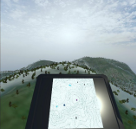 | Hiroshi Furuya; Zubin Choudhary; Jasmine Joyce DeGuzman; Matt Gottsacker; Gerd Bruder; Greg Welch Using Simulated Real-world Terrain in VR to Study Outdoor AR Topographic Map Interfaces Proceedings Article In: Proceedings of the International Conference on Artificial Reality and Telexistence and Eurographics Symposium on Virtual Environments (ICAT-EGVE 2024), Tsukuba, Japan, December 1-3, 2024, pp. 1-10, 2024. @inproceedings{Furuya2024topo,
title = {Using Simulated Real-world Terrain in VR to Study Outdoor AR Topographic Map Interfaces},
author = {Hiroshi Furuya and Zubin Choudhary and Jasmine Joyce DeGuzman and Matt Gottsacker and Gerd Bruder and Greg Welch},
url = {https://sreal.ucf.edu/wp-content/uploads/2024/10/cameraready_ICAT_EGVE_2024_1029_topographic_map.pdf},
doi = {tbd},
year = {2024},
date = {2024-12-01},
urldate = {2024-12-01},
booktitle = {Proceedings of the International Conference on Artificial Reality and Telexistence and Eurographics Symposium on Virtual Environments (ICAT-EGVE 2024), Tsukuba, Japan, December 1-3, 2024},
pages = {1-10},
abstract = {Augmented reality (AR) technology enables advanced integration of spatial information useful in a variety of important domains, including for reading topographic maps in the field. It is also important to understand how this technology may potentially affect spatial learning ability. In this paper, we demonstrate the use of virtual reality (VR) to conduct a human-subject study investigating the impacts of different simulated AR topographic map interface designs on spatial learning outcomes. Our results show that interfaces that encourage engagement with the interface instead of with the map and the environment result in fast task completion times but poor spatial learning. We also found participant preference for a novel interface design that assists users with map orientation without explicitly guiding the user through the task.},
keywords = {},
pubstate = {published},
tppubtype = {inproceedings}
}
Augmented reality (AR) technology enables advanced integration of spatial information useful in a variety of important domains, including for reading topographic maps in the field. It is also important to understand how this technology may potentially affect spatial learning ability. In this paper, we demonstrate the use of virtual reality (VR) to conduct a human-subject study investigating the impacts of different simulated AR topographic map interface designs on spatial learning outcomes. Our results show that interfaces that encourage engagement with the interface instead of with the map and the environment result in fast task completion times but poor spatial learning. We also found participant preference for a novel interface design that assists users with map orientation without explicitly guiding the user through the task. |
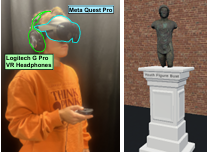 | Zubin Choudhary; Laura Battistel; Raiffa Syamil; Hiroshi Furuya; Ferran Argelaguet; Gerd Bruder; Gregory F. Welch Examining the Effects of Teleportation on Semantic Memory of a Virtual Museum Compared to Natural Walking Proceedings Article In: Proceedings of the International Conference on Artificial Reality and Telexistence and Eurographics Symposium on Virtual Environments (ICAT-EGVE 2024), Tsukuba, Japan, December 1-3, 2024, pp. 1-12, 2024. @inproceedings{Choudhary2024walking,
title = {Examining the Effects of Teleportation on Semantic Memory of a Virtual Museum Compared to Natural Walking},
author = {Zubin Choudhary and Laura Battistel and Raiffa Syamil and Hiroshi Furuya and Ferran Argelaguet and Gerd Bruder and Gregory F. Welch},
url = {https://sreal.ucf.edu/wp-content/uploads/2024/10/paper1028_2.pdf},
year = {2024},
date = {2024-12-01},
urldate = {2024-12-01},
booktitle = {Proceedings of the International Conference on Artificial Reality and Telexistence and Eurographics Symposium on Virtual Environments (ICAT-EGVE 2024), Tsukuba, Japan, December 1-3, 2024},
pages = {1-12},
abstract = {Over the past decades there has been extensive research investigating the trade-offs between various Virtual Reality (VR) locomotion techniques. One of the most highly researched techniques is teleportation, due to its ability to quickly traverse large virtual spaces even in limited physical tracking spaces. The majority of teleportation research has been focused on its effects on spatial cognition, such as spatial understanding and retention. However, relatively little is known about whether the use of teleportation in immersive learning experiences can effect the acquisition of semantic knowledge — our knowledge about facts, concepts, and ideas — which is essential for long-term learning. In this paper we present a human-subjects study to investigate the effects of teleportation compared to natural walking on the retention of semantic information about artifacts in a virtual museum. Participants visited unique 3D artifacts accompanied by audio clips and artifact names. Our results show that participants reached the same semantic memory performance with both locomotion techniques but with different behaviors, self-assessed performance, and preference. In particular, participants subjectively indicated that they felt that they recalled more semantic memory with walking than teleportation. However, objectively, they spent more time with the artifacts while walking, meaning that they learnt less per a set amount of time than with teleportation. We discuss the relationships, implications, and guidelines for VR experiences designed to help users acquire new knowledge.},
keywords = {},
pubstate = {published},
tppubtype = {inproceedings}
}
Over the past decades there has been extensive research investigating the trade-offs between various Virtual Reality (VR) locomotion techniques. One of the most highly researched techniques is teleportation, due to its ability to quickly traverse large virtual spaces even in limited physical tracking spaces. The majority of teleportation research has been focused on its effects on spatial cognition, such as spatial understanding and retention. However, relatively little is known about whether the use of teleportation in immersive learning experiences can effect the acquisition of semantic knowledge — our knowledge about facts, concepts, and ideas — which is essential for long-term learning. In this paper we present a human-subjects study to investigate the effects of teleportation compared to natural walking on the retention of semantic information about artifacts in a virtual museum. Participants visited unique 3D artifacts accompanied by audio clips and artifact names. Our results show that participants reached the same semantic memory performance with both locomotion techniques but with different behaviors, self-assessed performance, and preference. In particular, participants subjectively indicated that they felt that they recalled more semantic memory with walking than teleportation. However, objectively, they spent more time with the artifacts while walking, meaning that they learnt less per a set amount of time than with teleportation. We discuss the relationships, implications, and guidelines for VR experiences designed to help users acquire new knowledge. |
 | Matt Gottsacker; Hiroshi Furuya; Laura Battistel; Carlos Pinto Jimenez; Nicholas LaMontagna; Gerd Bruder; and Gregory F. Welch Exploring Spatial Cognitive Residue and Methods to Clear Users’ Minds When Transitioning Between Virtual Environments Proceedings Article In: IEEE International Symposium of Mixed and Augmented Reality (ISMAR), pp. 1-11, 2024. @inproceedings{nokey,
title = {Exploring Spatial Cognitive Residue and Methods to Clear Users’ Minds When Transitioning Between Virtual Environments},
author = {Matt Gottsacker and Hiroshi Furuya and Laura Battistel and Carlos Pinto Jimenez and Nicholas LaMontagna and Gerd Bruder and and Gregory F. Welch},
url = {https://sreal.ucf.edu/wp-content/uploads/2024/08/ISMAR24____Conference____Residue-5.pdf},
year = {2024},
date = {2024-10-21},
urldate = {2024-10-21},
booktitle = {IEEE International Symposium of Mixed and Augmented Reality (ISMAR)},
pages = {1-11},
abstract = {In most cases, retaining memories of things we have experienced in the past is desirable, but in some cases, we want to clear our minds so that we may focus completely on subsequent activities. When someone switches from one task to another, they commonly incur some “cognitive residue” where some of their cognitive resources such as working memory and attention remain devoted to their previous task even after they try to switch their focus to their new task. This residue could have a negative impact on their performance in the next task, and in such circumstances, it is important to reduce that residue. In this paper, we explore the concept of cognitive residue in the context of switching between virtual reality (VR) environments. We conducted a human-subject experiment (N=24) with a spatial recall task to investigate how different visual transitions might reduce participants’ spatial cognitive residue. In this instance, more errors on the recall task corresponds to less spatial cognitive residue. We found that transitions that lasted one minute successfully reduced spatial cognitive residue: they significantly reduced participants’ abilities to recall the positions of objects in their previous VE compared to an instantaneous cut transition. Additionally, for transitions that showed a nature scene, greater head movement significantly correlated with more spatial memory errors (i.e., less spatial cognitive residue). We discuss how these findings can be applied to support users transitioning between virtual tasks and environments in VR task switching scenarios.},
keywords = {},
pubstate = {published},
tppubtype = {inproceedings}
}
In most cases, retaining memories of things we have experienced in the past is desirable, but in some cases, we want to clear our minds so that we may focus completely on subsequent activities. When someone switches from one task to another, they commonly incur some “cognitive residue” where some of their cognitive resources such as working memory and attention remain devoted to their previous task even after they try to switch their focus to their new task. This residue could have a negative impact on their performance in the next task, and in such circumstances, it is important to reduce that residue. In this paper, we explore the concept of cognitive residue in the context of switching between virtual reality (VR) environments. We conducted a human-subject experiment (N=24) with a spatial recall task to investigate how different visual transitions might reduce participants’ spatial cognitive residue. In this instance, more errors on the recall task corresponds to less spatial cognitive residue. We found that transitions that lasted one minute successfully reduced spatial cognitive residue: they significantly reduced participants’ abilities to recall the positions of objects in their previous VE compared to an instantaneous cut transition. Additionally, for transitions that showed a nature scene, greater head movement significantly correlated with more spatial memory errors (i.e., less spatial cognitive residue). We discuss how these findings can be applied to support users transitioning between virtual tasks and environments in VR task switching scenarios. |
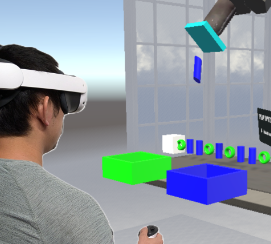 | Hiroshi Furuya; Laura Battistel; Zubin Datta Choudhary; Matt Gottsacker; Gerd Bruder; Gregory F Welch Difficulties in Perceiving and Understanding Robot Reliability Changes in a Sequential Binary Task Proceedings Article In: Proceedings of the 2024 ACM Symposium on Spatial User Interaction, pp. 1-11, Association for Computing Machinery, Trier, Germany, 2024, ISBN: 9798400710889. @inproceedings{Furuya2024perceive,
title = {Difficulties in Perceiving and Understanding Robot Reliability Changes in a Sequential Binary Task},
author = {Hiroshi Furuya and Laura Battistel and Zubin Datta Choudhary and Matt Gottsacker and Gerd Bruder and Gregory F Welch},
url = {https://sreal.ucf.edu/wp-content/uploads/2024/08/SUI_2024___Difficulties_in_Perceiving_and_Understanding_Robot_Reliability_Changes_in_a_Sequential_Binary_Task-1-2.pdf},
doi = {10.1145/3677386.3682083},
isbn = {9798400710889},
year = {2024},
date = {2024-10-07},
urldate = {2024-10-07},
booktitle = {Proceedings of the 2024 ACM Symposium on Spatial User Interaction},
pages = {1-11},
publisher = {Association for Computing Machinery},
address = {Trier, Germany},
series = {SUI '24},
abstract = {Human-robot teams push the boundaries of what both humans and robots can accomplish. In order for the team to function well, the human must accurately assess the robot’s capabilities to calibrate the trust between the human and robot. In this paper, we use virtual reality (VR), a widely accepted tool in studying human-robot interaction (HRI), to study human behaviors affecting their detection and understanding of changes in a simulated robot’s reliability. We present a human-subject study to see how different reliability change factors may affect this process. Our results demonstrate that participants make judgements about robot reliability before they have accumulated sufficient evidence to make objectively high-confidence inferences about robot reliability. We show that this reliability change observation behavior diverges from behavior expectations based on the probability distribution functions used to describe observation outcomes.},
keywords = {},
pubstate = {published},
tppubtype = {inproceedings}
}
Human-robot teams push the boundaries of what both humans and robots can accomplish. In order for the team to function well, the human must accurately assess the robot’s capabilities to calibrate the trust between the human and robot. In this paper, we use virtual reality (VR), a widely accepted tool in studying human-robot interaction (HRI), to study human behaviors affecting their detection and understanding of changes in a simulated robot’s reliability. We present a human-subject study to see how different reliability change factors may affect this process. Our results demonstrate that participants make judgements about robot reliability before they have accumulated sufficient evidence to make objectively high-confidence inferences about robot reliability. We show that this reliability change observation behavior diverges from behavior expectations based on the probability distribution functions used to describe observation outcomes. |
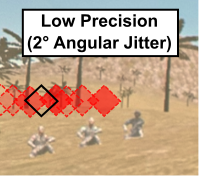 | Matt Gottsacker; Hiroshi Furuya; Zubin Choudhary; Austin Erickson; Ryan Schubert; Gerd Bruder; Michael P. Browne; Gregory F. Welch Investigating the relationships between user behaviors and tracking factors on task performance and trust in augmented reality Journal Article In: Elsevier Computers & Graphics, vol. 123, pp. 1-14, 2024. @article{gottsacker2024trust,
title = {Investigating the relationships between user behaviors and tracking factors on task performance and trust in augmented reality},
author = {Matt Gottsacker and Hiroshi Furuya and Zubin Choudhary and Austin Erickson and Ryan Schubert and Gerd Bruder and Michael P. Browne and Gregory F. Welch},
url = {https://sreal.ucf.edu/wp-content/uploads/2024/08/C_G____ARTrust____Accuracy___Precision.pdf},
doi = {https://doi.org/10.1016/j.cag.2024.104035},
year = {2024},
date = {2024-08-06},
urldate = {2024-08-06},
journal = {Elsevier Computers & Graphics},
volume = {123},
pages = {1-14},
abstract = {This research paper explores the impact of augmented reality (AR) tracking characteristics, specifically an AR head-worn display's tracking registration accuracy and precision, on users' spatial abilities and subjective perceptions of trust in and reliance on the technology. Our study aims to clarify the relationships between user performance and the different behaviors users may employ based on varying degrees of trust in and reliance on AR. Our controlled experimental setup used a 360 field-of-regard search-and-selection task and combines the immersive aspects of a CAVE-like environment with AR overlays viewed with a head-worn display. We investigated three levels of simulated AR tracking errors in terms of both accuracy and precision (+0, +1, +2). We controlled for four user task behaviors that correspond to different levels of trust in and reliance on an AR system: AR-Only (only relying on AR), AR-First (prioritizing AR over real world), Real-Only (only relying on real world), and Real-First (prioritizing real world over AR). By controlling for these behaviors, our results showed that even small amounts of AR tracking errors had noticeable effects on users' task performance, especially if they relied completely on the AR cues (AR-Only). Our results link AR tracking characteristics with user behavior, highlighting the importance of understanding these elements to improve AR technology and user satisfaction.},
keywords = {},
pubstate = {published},
tppubtype = {article}
}
This research paper explores the impact of augmented reality (AR) tracking characteristics, specifically an AR head-worn display's tracking registration accuracy and precision, on users' spatial abilities and subjective perceptions of trust in and reliance on the technology. Our study aims to clarify the relationships between user performance and the different behaviors users may employ based on varying degrees of trust in and reliance on AR. Our controlled experimental setup used a 360 field-of-regard search-and-selection task and combines the immersive aspects of a CAVE-like environment with AR overlays viewed with a head-worn display. We investigated three levels of simulated AR tracking errors in terms of both accuracy and precision (+0, +1, +2). We controlled for four user task behaviors that correspond to different levels of trust in and reliance on an AR system: AR-Only (only relying on AR), AR-First (prioritizing AR over real world), Real-Only (only relying on real world), and Real-First (prioritizing real world over AR). By controlling for these behaviors, our results showed that even small amounts of AR tracking errors had noticeable effects on users' task performance, especially if they relied completely on the AR cues (AR-Only). Our results link AR tracking characteristics with user behavior, highlighting the importance of understanding these elements to improve AR technology and user satisfaction. |
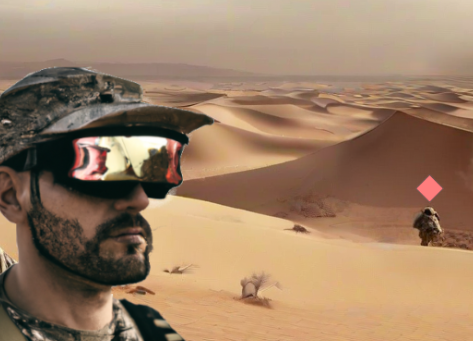 | Gerd Bruder; Michael Browne; Zubin Choudhary; Austin Erickson; Hiroshi Furuya; Matt Gottsacker; Ryan Schubert; Gregory Welch Visual Factors Influencing Trust and Reliance with Augmented Reality Systems Journal Article In: Journal of Vision Abstracts—Vision Sciences Society (VSS) Annual Meeting, 2024. @article{Bruder2024,
title = {Visual Factors Influencing Trust and Reliance with Augmented Reality Systems},
author = {Gerd Bruder and Michael Browne and Zubin Choudhary and Austin Erickson and Hiroshi Furuya and Matt Gottsacker and Ryan Schubert and Gregory Welch},
year = {2024},
date = {2024-05-17},
urldate = {2024-05-17},
journal = {Journal of Vision Abstracts—Vision Sciences Society (VSS) Annual Meeting},
abstract = {Augmented Reality (AR) systems are increasingly used for simulations, training, and operations across a wide range of application fields. Unfortunately, the imagery that current AR systems create often does not match our visual perception of the real world, which can make users feel like the AR system is not believable. This lack of belief can lead to negative training or experiences, where users lose trust in the AR system and adjust their reliance on AR. The latter is characterized by users adopting different cognitive perception-action pathways by which they integrate AR visual information for spatial tasks. In this work, we present a series of six within-subjects experiments (each N=20) in which we investigated trust in AR with respect to two display factors (field of view and visual contrast), two tracking factors (accuracy and precision), and two network factors (latency and dropouts). Participants performed a 360-degree visual search-and-selection task in a hybrid setup involving an AR head-mounted display and a CAVE-like simulated real environment. Participants completed the experiments with four perception-action pathways that represent different levels of the users’ reliance on an AR system: AR-Only (only relying on AR), AR-First (prioritizing AR over real world), Real-First (prioritizing real world over AR), and Real-Only (only relying on real world). Our results show that participants’ perception-action pathways and objective task performance were significantly affected by all six tested AR factors. In contrast, we found that their subjective responses for trust and reliance were often more affected by slight AR system differences than would elicit objective performance differences, and participants tended to overestimate or underestimate the trustworthiness of the AR system. Participants showed significantly higher task performance gains if their sense of trust was well-calibrated to the trustworthiness of the AR system, highlighting the importance of effectively managing users’ trust in future AR systems.
Acknowledgements: This material includes work supported in part by Vision Products LLC via US Air Force Research Laboratory (AFRL) Award Number FA864922P1038, and the Office of Naval Research under Award Numbers N00014-21-1-2578 and N00014-21-1-2882 (Dr. Peter Squire, Code 34).},
keywords = {},
pubstate = {published},
tppubtype = {article}
}
Augmented Reality (AR) systems are increasingly used for simulations, training, and operations across a wide range of application fields. Unfortunately, the imagery that current AR systems create often does not match our visual perception of the real world, which can make users feel like the AR system is not believable. This lack of belief can lead to negative training or experiences, where users lose trust in the AR system and adjust their reliance on AR. The latter is characterized by users adopting different cognitive perception-action pathways by which they integrate AR visual information for spatial tasks. In this work, we present a series of six within-subjects experiments (each N=20) in which we investigated trust in AR with respect to two display factors (field of view and visual contrast), two tracking factors (accuracy and precision), and two network factors (latency and dropouts). Participants performed a 360-degree visual search-and-selection task in a hybrid setup involving an AR head-mounted display and a CAVE-like simulated real environment. Participants completed the experiments with four perception-action pathways that represent different levels of the users’ reliance on an AR system: AR-Only (only relying on AR), AR-First (prioritizing AR over real world), Real-First (prioritizing real world over AR), and Real-Only (only relying on real world). Our results show that participants’ perception-action pathways and objective task performance were significantly affected by all six tested AR factors. In contrast, we found that their subjective responses for trust and reliance were often more affected by slight AR system differences than would elicit objective performance differences, and participants tended to overestimate or underestimate the trustworthiness of the AR system. Participants showed significantly higher task performance gains if their sense of trust was well-calibrated to the trustworthiness of the AR system, highlighting the importance of effectively managing users’ trust in future AR systems.
Acknowledgements: This material includes work supported in part by Vision Products LLC via US Air Force Research Laboratory (AFRL) Award Number FA864922P1038, and the Office of Naval Research under Award Numbers N00014-21-1-2578 and N00014-21-1-2882 (Dr. Peter Squire, Code 34). |
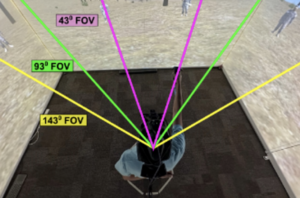 | Michael P. Browne; Gregory F. Welch; Gerd Bruder; Ryan Schubert Understanding the impact of trust on performance in a training system using augmented reality Proceedings Article In: Proceedings of SPIE Conference 13051: Artificial Intelligence and Machine Learning for Multi-Domain Operations Applications VI, 2024. @inproceedings{Browne2024ut,
title = {Understanding the impact of trust on performance in a training system using augmented reality},
author = {Michael P. Browne and Gregory F. Welch and Gerd Bruder and Ryan Schubert},
year = {2024},
date = {2024-04-22},
urldate = {2024-04-22},
booktitle = {Proceedings of SPIE Conference 13051: Artificial Intelligence and Machine Learning for Multi-Domain Operations Applications VI},
abstract = {The information presented by AR systems may not be 100% accurate, and anomalies like tracker errors, lack of opacity compared to the background and reduced field of view (FOV) can make users feel like an AR training system is not believable. This lack of belief can lead to negative training, where trainees adjust how they train due to flaws in the training system and are therefore less prepared for actual battlefield situations. We have completed an experiment to investigate trust, reliance, and human task performance in an augmented reality three-dimensional experimental scenario. Specifically, we used a methodology in which simulated real (complex) entities are supplemented by abstracted (basic) cues presented as overlays in an AR head mounted display (HMD) in a visual search and awareness task. We simulated properties of different AR displays to determine which of the properties most affect training efficacy. Results from our experiment will feed directly into the design of training systems that use AR/MR displays and will help increase the efficacy of training.},
keywords = {},
pubstate = {published},
tppubtype = {inproceedings}
}
The information presented by AR systems may not be 100% accurate, and anomalies like tracker errors, lack of opacity compared to the background and reduced field of view (FOV) can make users feel like an AR training system is not believable. This lack of belief can lead to negative training, where trainees adjust how they train due to flaws in the training system and are therefore less prepared for actual battlefield situations. We have completed an experiment to investigate trust, reliance, and human task performance in an augmented reality three-dimensional experimental scenario. Specifically, we used a methodology in which simulated real (complex) entities are supplemented by abstracted (basic) cues presented as overlays in an AR head mounted display (HMD) in a visual search and awareness task. We simulated properties of different AR displays to determine which of the properties most affect training efficacy. Results from our experiment will feed directly into the design of training systems that use AR/MR displays and will help increase the efficacy of training. |
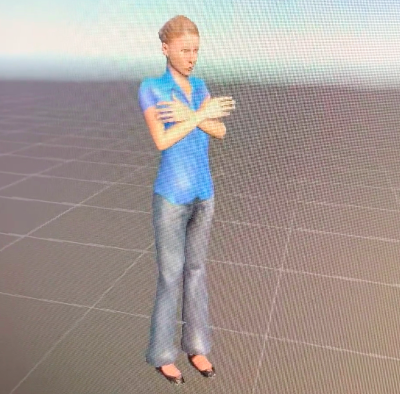 | Laura Battistel; Matt Gottsacker; Greg Welch; Gerd Bruder; Massimiliano Zampini; Riccardo Parin Chill or Warmth: Exploring Temperature's Impact on Interpersonal Boundaries in VR Proceedings Article In: Adjunct Proceedings of the IEEE Conference on Virtual Reality and 3D User Interfaces (IEEE VR): 2nd Annual Workshop on Multi-modal Affective and Social Behavior Analysis and Synthesis in Extended Reality (MASSXR), pp. 1-3, 2024. @inproceedings{Battistel2024co,
title = {Chill or Warmth: Exploring Temperature's Impact on Interpersonal Boundaries in VR},
author = {Laura Battistel and Matt Gottsacker and Greg Welch and Gerd Bruder and Massimiliano Zampini and Riccardo Parin},
url = {https://sreal.ucf.edu/wp-content/uploads/2024/02/Battistel2024co.pdf},
year = {2024},
date = {2024-03-16},
urldate = {2024-03-16},
booktitle = {Adjunct Proceedings of the IEEE Conference on Virtual Reality and 3D User Interfaces (IEEE VR): 2nd Annual Workshop on Multi-modal Affective and Social Behavior Analysis and Synthesis in Extended Reality (MASSXR)},
pages = {1-3},
abstract = {This position paper outlines a study on the influence of avatars displaying warmth or coldness cues on interpersonal space in virtual reality. Participants will engage in a comfort-distance task, approaching avatars exhibiting thermoregulatory behaviors. Anticipated findings include a reduction in interpersonal distance with warm cues and an increase with cold cues. The study will offer insights into the complex interplay between temperature, social perception, and interpersonal space.},
keywords = {},
pubstate = {published},
tppubtype = {inproceedings}
}
This position paper outlines a study on the influence of avatars displaying warmth or coldness cues on interpersonal space in virtual reality. Participants will engage in a comfort-distance task, approaching avatars exhibiting thermoregulatory behaviors. Anticipated findings include a reduction in interpersonal distance with warm cues and an increase with cold cues. The study will offer insights into the complex interplay between temperature, social perception, and interpersonal space. |
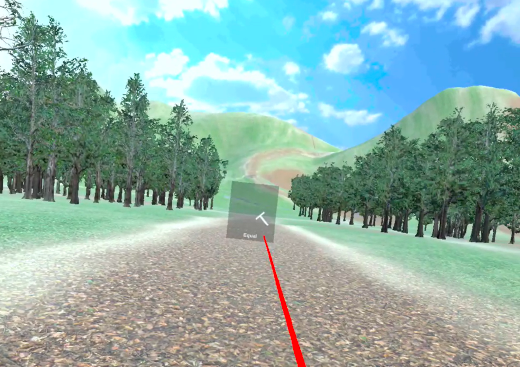 | Fariba Mostajeran; Sebastian Schneider; Gerd Bruder; Simone Kühn; Frank Steinicke Analyzing Cognitive Demands and Detection Thresholds for Redirected Walking in Immersive Forest and Urban Environments Proceedings Article In: Proceedings of IEEE Virtual Reality (VR), pp. 1-11, 2024. @inproceedings{Mostajeran2024ac,
title = {Analyzing Cognitive Demands and Detection Thresholds for Redirected Walking in Immersive Forest and Urban Environments},
author = {Fariba Mostajeran and Sebastian Schneider and Gerd Bruder and Simone Kühn and Frank Steinicke},
year = {2024},
date = {2024-03-16},
booktitle = {Proceedings of IEEE Virtual Reality (VR)},
pages = {1-11},
abstract = {Redirected walking is a locomotion technique that allows users to naturally walk through large immersive virtual environments (IVEs) by guiding them on paths that might vary from the paths they walk in the real world. While this technique enables the exploration of larger spaces in the IVE via natural walking, previous work has shown that it induces extra cognitive load for the users. On the other hand, previous research has shown that exposure to virtual nature environments can restore users’ diminished attentional capacities and lead to enhanced cognitive performances. Therefore, the aim of this paper is to investigate if the environment in which the user is redirected has the potential to reduce its cognitive demands. For this purpose, we conducted an experiment with 28 participants, who performed a spatial working memory task (i.e., 2-back test) while walking and being redirected with different gains in two different IVEs (i.e., (i) forest and (ii) urban). The results of frequentist and Bayesian analysis are consistent and provide evidence against an effect of the type of IVE on detection thresholds as well as cognitive and locomotion performances. Therefore, redirected walking is robust to the variation of the IVEs tested in this experiment. The results partly challenge previous research findings and, therefore, require future work in this direction.},
keywords = {},
pubstate = {published},
tppubtype = {inproceedings}
}
Redirected walking is a locomotion technique that allows users to naturally walk through large immersive virtual environments (IVEs) by guiding them on paths that might vary from the paths they walk in the real world. While this technique enables the exploration of larger spaces in the IVE via natural walking, previous work has shown that it induces extra cognitive load for the users. On the other hand, previous research has shown that exposure to virtual nature environments can restore users’ diminished attentional capacities and lead to enhanced cognitive performances. Therefore, the aim of this paper is to investigate if the environment in which the user is redirected has the potential to reduce its cognitive demands. For this purpose, we conducted an experiment with 28 participants, who performed a spatial working memory task (i.e., 2-back test) while walking and being redirected with different gains in two different IVEs (i.e., (i) forest and (ii) urban). The results of frequentist and Bayesian analysis are consistent and provide evidence against an effect of the type of IVE on detection thresholds as well as cognitive and locomotion performances. Therefore, redirected walking is robust to the variation of the IVEs tested in this experiment. The results partly challenge previous research findings and, therefore, require future work in this direction. |
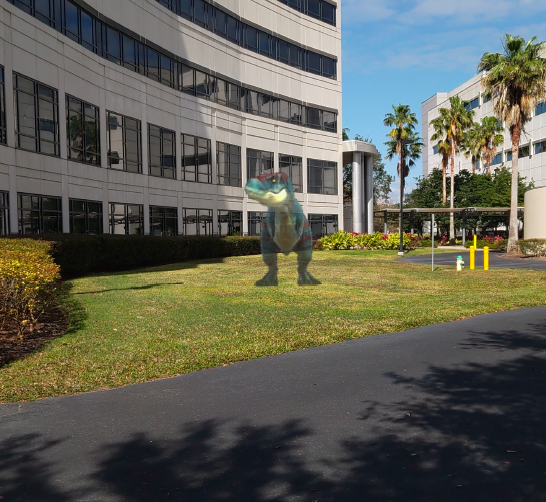 | Juanita Benjamin; Austin Erickson; Matt Gottsacker; Gerd Bruder; Gregory Welch Evaluating Transitive Perceptual Effects Between Virtual Entities in Outdoor Augmented Reality Proceedings Article In: Proceedings of IEEE Virtual Reality (VR), pp. 1-11, 2024. @inproceedings{Benjamin2024et,
title = {Evaluating Transitive Perceptual Effects Between Virtual Entities in Outdoor Augmented Reality},
author = {Juanita Benjamin and Austin Erickson and Matt Gottsacker and Gerd Bruder and Gregory Welch},
url = {https://sreal.ucf.edu/wp-content/uploads/2024/02/Benjamin2024.pdf},
year = {2024},
date = {2024-03-16},
urldate = {2024-03-16},
booktitle = {Proceedings of IEEE Virtual Reality (VR)},
pages = {1-11},
abstract = {Augmented reality (AR) head-mounted displays (HMDs) provide users with a view in which digital content is blended spatially with the outside world. However, one critical issue faced with such display technologies is misperception, i.e., perceptions of computer-generated content that differs from our human perception of other real-world objects or entities. Misperception can lead to mistrust in these systems and negative impacts in a variety of application fields. Although there is a considerable amount of research investigating either size, distance, or speed misperception in AR, far less is known about the relationships between these aspects. In this paper, we present an outdoor AR experiment (N=20) using a HoloLens 2 HMD. Participants estimated size, distance, and speed of Familiar and Unfamiliar outdoor animals at three distances (30, 60, 90 meters). To investigate whether providing information about one aspect may influence another, we divided our experiment into three phases. In Phase I, participants estimated the three aspects without any provided information. In Phase II, participants were given accurate size information, then asked to estimate distance and speed. In Phase III, participants were given accurate distance and size information, then asked to estimate speed. Our results show that estimates of speed in particular of the Unfamiliar animals benefited from provided size information, while speed estimates of all animals benefited from provided distance information. We found no support for the assumption that distance estimates benefited from provided size information.},
keywords = {},
pubstate = {published},
tppubtype = {inproceedings}
}
Augmented reality (AR) head-mounted displays (HMDs) provide users with a view in which digital content is blended spatially with the outside world. However, one critical issue faced with such display technologies is misperception, i.e., perceptions of computer-generated content that differs from our human perception of other real-world objects or entities. Misperception can lead to mistrust in these systems and negative impacts in a variety of application fields. Although there is a considerable amount of research investigating either size, distance, or speed misperception in AR, far less is known about the relationships between these aspects. In this paper, we present an outdoor AR experiment (N=20) using a HoloLens 2 HMD. Participants estimated size, distance, and speed of Familiar and Unfamiliar outdoor animals at three distances (30, 60, 90 meters). To investigate whether providing information about one aspect may influence another, we divided our experiment into three phases. In Phase I, participants estimated the three aspects without any provided information. In Phase II, participants were given accurate size information, then asked to estimate distance and speed. In Phase III, participants were given accurate distance and size information, then asked to estimate speed. Our results show that estimates of speed in particular of the Unfamiliar animals benefited from provided size information, while speed estimates of all animals benefited from provided distance information. We found no support for the assumption that distance estimates benefited from provided size information. |
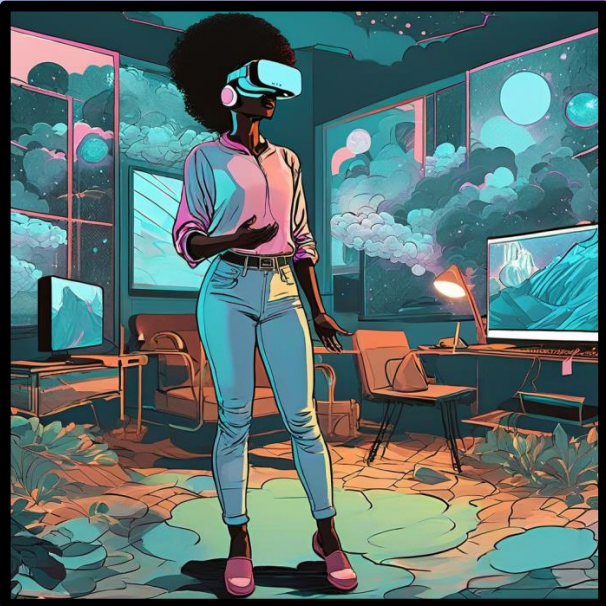 | Matt Gottsacker; Gerd Bruder; Gregory F. Welch rlty2rlty: Transitioning Between Realities with Generative AI Proceedings Article In: Proceedings of IEEE Conference on Virtual Reality and 3D User Interfaces (VR), pp. 1–2, 2024. @inproceedings{nokey,
title = {rlty2rlty: Transitioning Between Realities with Generative AI},
author = {Matt Gottsacker and Gerd Bruder and Gregory F. Welch},
url = {https://sreal.ucf.edu/wp-content/uploads/2024/02/vr24d-sub1075-cam-i5.pdf
https://www.youtube.com/watch?v=u4CyvdE3Y3g},
year = {2024},
date = {2024-02-20},
urldate = {2024-02-20},
booktitle = {Proceedings of IEEE Conference on Virtual Reality and 3D User Interfaces (VR)},
pages = {1--2},
abstract = {We present a system for visually transitioning a mixed reality (MR) user between two arbitrary realities (e.g., between two virtual worlds or between the real environment and a virtual world). The system uses artificial intelligence (AI) to generate a 360° video that transforms the user’s starting environment to another environment, passing through a liminal space that could help them relax between tasks or prepare them for the ending environment. The video can then be viewed on an MR headset.},
keywords = {},
pubstate = {published},
tppubtype = {inproceedings}
}
We present a system for visually transitioning a mixed reality (MR) user between two arbitrary realities (e.g., between two virtual worlds or between the real environment and a virtual world). The system uses artificial intelligence (AI) to generate a 360° video that transforms the user’s starting environment to another environment, passing through a liminal space that could help them relax between tasks or prepare them for the ending environment. The video can then be viewed on an MR headset. |
2023
|
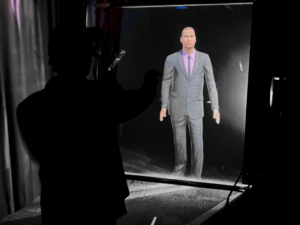 | Juanita Benjamin; Gerd Bruder; Carsten Neumann; Dirk Reiners; Carolina Cruz-Neira; Gregory F Welch Perception and Proxemics with Virtual Humans on Transparent Display Installations in Augmented Reality Proceedings Article In: Proceedings of the IEEE Conference on International Symposium on Mixed and Augmented Reality (ISMAR) 2023., pp. 1–10, 2023. @inproceedings{benjamin2023arscreen,
title = {Perception and Proxemics with Virtual Humans on Transparent Display Installations in Augmented Reality},
author = {Juanita Benjamin and Gerd Bruder and Carsten Neumann and Dirk Reiners and Carolina Cruz-Neira and Gregory F Welch },
url = {https://sreal.ucf.edu/wp-content/uploads/2023/08/Perception-and-Proxemics-ISMAR-23-2.pdf},
year = {2023},
date = {2023-10-21},
urldate = {2023-10-21},
booktitle = {Proceedings of the IEEE Conference on International Symposium on Mixed and Augmented Reality (ISMAR) 2023.},
pages = {1--10},
abstract = {It is not uncommon for science fiction movies to portray futuristic user interfaces that can only be realized decades later with state-of-the-art technology. In this work, we present a prototypical augmented reality (AR) installation that was inspired by the movie The Time Machine (2002). It consists of a transparent screen that acts as a window through which users can see the stereoscopic projection of a three-dimensional virtual human (VH). However, there are some key differences between the vision of this technology and the way VHs on these displays are actually perceived. In particular, the additive light model of these displays causes darker VHs to appear more transparent, while light in the physical environment further increases transparency, which may affect the way VHs are perceived, to what degree they are trusted, and the distances one maintains from them in a spatial setting. In this paper, we present a user study in which we investigate how transparency in the scope of transparent AR screens affects the perception of a VH's appearance, social presence with the VH, and the social space around users as defined by proxemics theory. Our results indicate that appearances are comparatively robust to transparency, while social presence improves in darker physical environments, and proxemic distances to the VH largely depend on one's distance from the screen but are not noticeably affected by transparency. Overall, our results suggest that such transparent AR screens can be an effective technology for facilitating social interactions between users and VHs in a shared physical space.},
keywords = {},
pubstate = {published},
tppubtype = {inproceedings}
}
It is not uncommon for science fiction movies to portray futuristic user interfaces that can only be realized decades later with state-of-the-art technology. In this work, we present a prototypical augmented reality (AR) installation that was inspired by the movie The Time Machine (2002). It consists of a transparent screen that acts as a window through which users can see the stereoscopic projection of a three-dimensional virtual human (VH). However, there are some key differences between the vision of this technology and the way VHs on these displays are actually perceived. In particular, the additive light model of these displays causes darker VHs to appear more transparent, while light in the physical environment further increases transparency, which may affect the way VHs are perceived, to what degree they are trusted, and the distances one maintains from them in a spatial setting. In this paper, we present a user study in which we investigate how transparency in the scope of transparent AR screens affects the perception of a VH's appearance, social presence with the VH, and the social space around users as defined by proxemics theory. Our results indicate that appearances are comparatively robust to transparency, while social presence improves in darker physical environments, and proxemic distances to the VH largely depend on one's distance from the screen but are not noticeably affected by transparency. Overall, our results suggest that such transparent AR screens can be an effective technology for facilitating social interactions between users and VHs in a shared physical space. |





![[Poster] Inducing Unintentional Positional Drift (UPD) in Virtual Reality via Physical Rotations and the Illusion of Leaning](https://sreal.ucf.edu/wp-content/uploads/2025/03/Roll-Example-e1741105590923-150x150.jpg)














